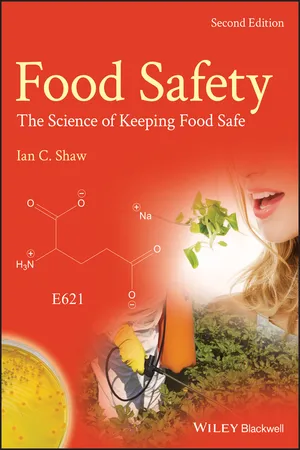
- English
- ePUB (mobile friendly)
- Available on iOS & Android
About this book
Food safety is a multi-faceted subject, using microbiology, chemistry, standards and regulations, and risk management to address issues involving bacterial pathogens, chemical contaminants, natural toxicants, additive safety, allergens, and more.
This revised edition has been updated with the latest information on food safety. It addresses all the topics pertinent to a full understanding of keeping the food we eat safe. Each chapter of Food Safety: The Science of Keeping Food Safe, Second Edition proceeds from introductory concepts and builds towards a sophisticated treatment of the topic, allowing the reader to take what knowledge is required for understanding food safety at a wide range of levels. Illustrated with photographs and examples throughout, this new edition also boasts 4 new chapters covering radioactivity in food; food terrorism; food authenticity; and food supplements.
• This second edition has been revised and updated throughout to include the latest topics in this fast-moving field
• Includes 4 brand new chapters on radioactivity in food, food terrorism, food authenticity, and food supplements
• The most readable and user-friendly food safety book for students, scientists, regulators, and general readers
Food Safety is the ideal starting point for students and non-specialists seeking to learn about food safety issues, and an enjoyable and stylish read for those who already have an academic or professional background in the area.
Frequently asked questions
- Essential is ideal for learners and professionals who enjoy exploring a wide range of subjects. Access the Essential Library with 800,000+ trusted titles and best-sellers across business, personal growth, and the humanities. Includes unlimited reading time and Standard Read Aloud voice.
- Complete: Perfect for advanced learners and researchers needing full, unrestricted access. Unlock 1.4M+ books across hundreds of subjects, including academic and specialized titles. The Complete Plan also includes advanced features like Premium Read Aloud and Research Assistant.
Please note we cannot support devices running on iOS 13 and Android 7 or earlier. Learn more about using the app.
Information
Chapter 1
Introduction
Introduction
A brief history of food safety
Prehistoric times
Evolution of cellular protection mechanisms



Tudor England (1485–1603)
The times of King George III of England (1760–1820)
Table of contents
- Cover
- Title Page
- Table of Contents
- Acknowledgements
- Chapter 1: Introduction
- Chapter 2: Food Risk
- Chapter 3: Bacteria
- Chapter 4: Viruses
- Chapter 5: Parasites
- Chapter 6: Bovine Spongiform Encephalopathy (BSE)
- Chapter 7: Chemical Contaminants
- Chapter 8: Natural Toxins
- Chapter 9: Endocrine Disrupting Chemicals
- Chapter 10: Genetically Modified Food
- Chapter 11: Colours, Flavours and Preservatives
- Chapter 12: Food Irradiation
- Chapter 13: Food Safety and the Unborn Child
- Chapter 14: Organic Food
- Chapter 15: Food Allergy
- Chapter 16: Food Legislation
- Chapter 17: Radioactivity in Food
- Chapter 18: Food Supplements
- Chapter 19: Food Terrorism
- Chapter 20: Food Authenticity
- Index
- End User License Agreement